7. Map and Terrain
Focus: This section provides more information on the types of terrain (physical and human) on the game and how ownership is determined. It also covers the impact of Zones of Control and stacking on movement.
Key Points:
- The different types of terrain in the game and their effect on movement and combat
- The different ways in which control of hexes is modelled and its effect on the game
- The different types of Zones of Control and their impact on the game
The map displays the physical and political features of the area where the German-Soviet conflict mainly took place. The map extends from Siberia to the Atlantic and from the Arctic Ocean to the Sahara. Not all this area is playable in the campaign games and the shorter scenarios will be played in more limited areas.
The map includes both physical and human features as well as the rail networks crucial to supply both armies. A hex grid is used to regulate movement and combat and this can be turned off using Hotkey- Ctrl-G.
7.1 Map Area
Each hex on the map represents an area of 10 miles across and is classified as one specific type of terrain, though there may be additional features present in the hex or hex sides.
Rivers and less than full hex lakes follow hex sides and can slow or block movement across applicable hex sides.
Hexes may contain smaller towns, which can have factories, but do not normally have any terrain effect. Cities will offer substantial defensive bonuses.
Hexes may also be defined as coastal, allowing for the presence of ports in towns, city and urban hexes as well as naval movement.
Rail networks are represented by rail lines in hexes, which are used for strategic movement and supply.
Each hex is graded according to the quality of the road network and this has an impact on movement (38,6) and supply costs, especially in constricted terrain or during periods of poor weather.
7.2 Terrain
Terrain types and features are represented on the map area and can affect movement, combat and supply. See section 22.3 for impact on tactical and strategic movement and 23.5 for the impact on combat. Movement and combat effects are also summarized in appendix 38.6.
7.2.1 Types of Terrain Hexes
Each hex on the map is classified as having one dominant terrain type. By default hexes are treated as clear unless other terrain is present.
All terrain except clear, sand, desert, ferry and water hexes is considered covered terrain for air reconnaissance purposes (18.1.6).

7.2.2 Terrain Features
The following terrain features can be in addition to the terrain type in a hex. Some are purely political features, but others can impact movement, combat and supply.
Coast: Any type of terrain bordering ocean and sea water hexes. Coastal hexes can be used for naval transport if a friendly port is located in the hex and may be the target of an amphibious landing (24.7).
Port: Found in some town, city or urban locations in coastal hexes. Ports generate naval and amphibious transportation tonnage capacity as well as naval interdiction points.
Ferry: A special type of sea water hex that allows movement between two land hexes separated by the ferry hex.
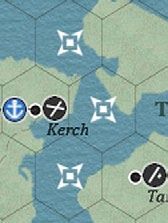
This shows the Kerch straights between the Crimea and Krasnodar regions.
Railroad: Rail lines run through hexes, with undamaged and linked rail lines forming a rail network that serves to link each sides supply grid.
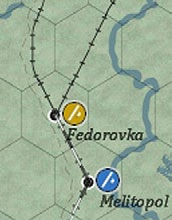
Note that all rail lines are either double track lines or single track (with much lower capacity). In the case above the line in Melitopol is a double track line, the two hexes at the top are single track lines.
Roads: Each hex has a road network ranging from poor to good. This can be seen by the indicative hex art, using the display road network filter and by using the hex pop-up.
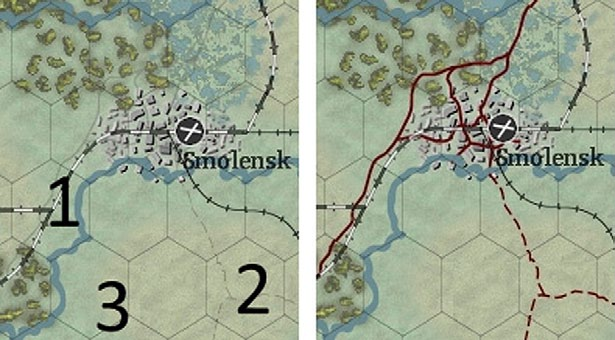
The left hand image is the normal map view showing hexes with good (1), average (2) and poor (3) roads (note there is no particular map art for poor road hexes). On the right is the same map section but with the road display enabled.
In general it is suggested that you use the road display filter, especially when planning operations as the few good roads offer substantial movement bonuses (especially in poor weather).
Named Locations: Some hexes on the map contain named locations. These are mostly towns and cities but also include hexes with an airbase or a depot. Urban locations are divided between Towns, Cities, Urban and Heavy Urban depending on the density of buildings. Towns etc. are also rated according to their population and 1 population point represents 50,000 people (note this includes the population in the surrounding countryside).
National Capital: This indicates the capital city of most nations on the map area.
Minor River hexside: Affects movement point costs and combat (2 in the image right)
Major River hexside: Affects movement point costs and combat (1 in the image right). Impassable Lake or River: Blocks movement, combat and supply tracing (3 in the image right).

Air Base Unit (Airfield): Displays presence of an air base unit in the hex. Symbols for Air Base units on the map reflect the size of the air base unit (1, 2 or 3).
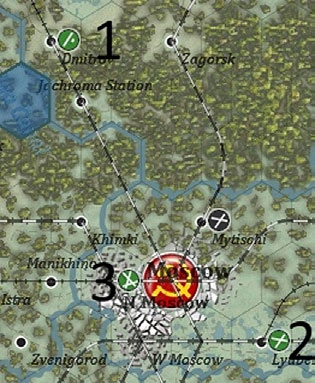
Depending on the map mode and the allocation of air units, the colour of a given airbase may differ from this (6.4.7).
7.2.3 Impassable Terrain
There are three types of impassable terrain in WiTE2.
Ground Unit Exclusion Zones: Units cannot rout into ground unit exclusion zones.
These areas are represented in one of two ways. Most are linked to the various Theatre Boxes (such as most of the Balkans in June 1941), others are on-map regions where specific units or nationalities are prevented from happening.
Typical of the first type are the Arctic and Balkan regions. However, some areas change status between being in a Theatre Box (13.3) and being on map as the game progresses. Examples of this include most of Serbia which will become playable once the Soviets are able to enter or of parts of Germany that will be removed from play in 1945 to reflect the final advances of the Western Allies.
Examples of on-map exclusion are the restrictions that prevent some of the Allied forces supporting the German invasion of the Soviet Union from entering certain hexes (14.2). Units can be retreated one hex into an exclusion zone.
Once there, they will automatically be displaced during their logistics phase to a nearby friendly town, city or urban hex.
Neutral (Impassable) Terrain: No air, ground or naval units may move, rout, or retreat into Spain, Turkey, Andorra, Switzerland, Sweden or Ireland. These areas are shown as neutral in the hex pop-up text.
Impassable River hexsides can be crossed if both sides are friendly controlled, paying the same cost as if crossing a frozen major river hexside.
7.2.4 Town, City and Urban Hexes
Town, city and urban hexes are terrain features or types that are population centres as well as locations for factories, ports and railyards.
Each population point is equivalent to 50,000 people (as in 1941). The density of the built up area in the hex is represented by the designations of Heavy Urban, Urban, City or Town. Note that the population reflects both those in the built-up section (i.e. the named location) and in the surrounding countryside.
This manpower is treated in the game as manpower factory points and this can be damaged, and repaired, as with any other type of factory.
The manpower currently in a hex may have changed from the initial population, at the 1941 scenario starts, due to combat, starvation and migration. Manpower thus represents the current recruiting potential of a town, city or urban hex and its surroundings, and is what generates replacement soldiers during the game.
7.2.5 Railways
In WiTE2 railways are divided into dual and single track lines. Single track lines only have 40% of the capacity of a dual track line.
If the rail move mode is enabled (F2) then additional information will be shown about the state of the rail network.
The symbol is dark green for undamaged rail, red for damaged rail and yellow or orange (this will vary according to whether the hex was repaired by a support unit or a player controlled rail repair unit) for rail undergoing repair that turn. Rail hexes that have white dots within a green circle are hexes that have been converted but are not connected to the rest of the rail network or are rail hexes that cannot be used for strategic rail movement or supply purposes due to being adjacent to enemy units.
When this mode is selected information is also provided about the wider rail network and repair options. Hexes further than 10 hexes or 25 MP from a railhead are shaded light grey, hexes further than 25 hexes or 100 MP from a railhead are shaded dark grey, enemy hexes are shaded rose, and rail repair HQ units are bordered in yellow.

This shows hexes more than 25 MP from the nearest functioning rail hex (1), hexes that are Axis controlled (2) and the location of a Soviet rail repair unit (3). In addition, it shows rails that have not been repaired (red), have been repaired this turn either by a Soviet NKPS rail repair unit (3, yellow) or a Soviet rail repair support unit (4, orange) and that are fully functioning (green).
The orange and yellow hexes will be fully functioning (green) in the next turn.
7.2.6 Roads
Each hex is graded for the quality of the road system. As in section 7.2.2, selecting the road display option will make these more obvious on the map.
In poor weather and restricted terrain (Mountains, Heavy Woods and Sand), better roads will significantly lower the movement and supply costs for units. This will also influence the speed of administrative movement if units are moving in friendly controlled hexes (22.2.1) that have no enemy interdiction.
7.2.7 Regions
In addition to national borders, the map is broken up into a number of regions. These affect the intensity of the partisan effort and are used for writing Events that affect the game (13.5).
The regional view can be accessed by right clicking on any hex, » Map information and the select Map Regions as:

7.3 Control of Hexes
7.3.1 Different Forms of Hex Control
Ground hexes are either friendly (controlled by the phasing player), enemy (controlled by the non-phasing player), or pending friendly.
The latter are hexes that have been taken during the current turn and will switch ownership at the end of the phasing player’s turn. There are additional costs for all units moving into enemy and pending friendly hexes to account for both timing issues and the inherent difficulty involved in moving into recently enemy held regions.
This shows friendly (1), pending friendly (2) and enemy controlled (3) hexes from the Axis point of view.
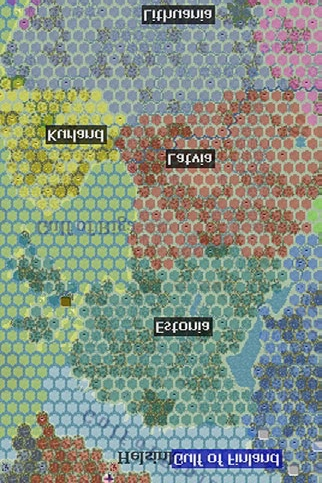
Ground units can enter enemy controlled hexes only if the hex is empty of any enemy combat units.
7.3.2 Impact of Enemy Controlled Hexes
Headquarters units are not allowed to move into enemy hexes, but may move into pending friendly hexes, representing the inability of headquarter units to move through areas that have not been cleared by combat units during the current turn.
Enemy controlled hexes block the tracing of supply, commitment of support units from headquarters during combat, and provision of support squad ground elements to units from headquarters units during the logistics phase.
Note that pending hexes do not block the commitment of combat units set to ‘reserve’ in combat (23.7).
7.3.3 Isolated Hex Conversion
Isolated hexes (23.14.1) that are not occupied by a friendly unit, or adjacent to a friendly combat unit may switch control to the other side automatically during friendly logistics phases. This will happen if they are adjacent to any enemy combat unit or within 2 hexes of an enemy division or corps sized unit.
Air base units in these hexes will be captured and become enemy controlled.
7.3.4 Air Base Unit Capture
Enemy Air Base units in hexes that become pending friendly or were isolated and convert to friendly control are captured and become empty (no support units) air base units for the capturing side.
When airbases are captured ready planes with enough pilots will be evacuated if sufficient amount of fuel is in the base (so any damaged planes will be lost).
In case of low fuel, the number of aircraft evacuated will be reduced. Evacuating aircraft will initially try to fly to the nearest air base that is more than 5 hexes from supplied enemy units. If they cannot meet those criteria, they will fly to any friendly air base unit.
Captured air base units are automatically reset to supply priority 3.
7.3.5 Control of Ferry Hexes
Players may only move and trace supply paths over ferry hexes if they control the hex by holding the ground hexes on either side.
If this is contested, then control of a Ferry hex is determined by the player with control of the greatest number of land hexes adjacent to the ferry. For this purpose each adjacent port that has a net level of at least 1 counts as an extra hex controlled. If there is a tie, the tiebreakers in order are:
- Side with greatest interdiction value in the hex.
- Side with most number of Combat Value (CV) points adjacent to the hex.
- If still tied, then the phasing player has control.
7.3.6 Control of Ocean and Sea Water Hexes
Control of ocean and sea water hexes is determined by the amount of naval interdiction projected by each side in the hex. Naval Interdiction values printed in sea hexes are displayed in brown for the Soviets and grey for Axis.
Naval interdiction is generated by nearby friendly controlled ports, the deployment of naval HQs and the naval interdiction air mission (18.1.8).
Control of an ocean or sea water hex is defined as having a map display adjusted interdiction level that is 2 greater than the enemy level. The map displayed values are the true value that is a number from 0-99, divided by 10 and then truncated. The true values are displayed in the hex pop-up, but the values shown on the map are the truncated /10 values, and it is these that are used for determining naval control of a hex.
Example: The Soviets have a real value of 32 (map value of 3) and the Axis player has a real value of 16 (map value of 1). Since the Map value of the Soviets is 2 or more than the map value of the Axis, the Soviets have control of the hex.
When interdiction is displayed, enemy controlled sea hexes are shown in red, neutral are shown darkened, and friendly control is shown normally.
The hex pop up will display current control with hex control indicated by the text Axis, SU (Soviets), or Neutral, which indicates contested water hexes. In the Action (Move) phase, if naval transport (F3) or amphibious transport (F4) mode is selected, then the impact of control of sea hexes on those modes of travel will be indicated as follows:
- Friendly controlled – nothing displayed
- Neutral – SHIPPING CONTESTED
- Enemy controlled – SHIPPING HEAVILY CONTESTED
- Enemy amphibious HQ unit and adjacent hexes – SHIPPING PROHIBITED
7.4 Zones of Control
Zones of Control (ZOC) represent the ability of ground combat units to exert control over the land map area in their vicinity and the area that they move through.
7.4.1 Impact on Enemy Movement
In WiTE2 all Combat Units exert a ZOC that will impede and slow enemy movement out of hexes adjacent to the unit.
Routed or depleted combat units, headquarters units and rail repair units do not have a ZOC.
If a unit has so few MP that it can only move 1 hex then it will not be able to move even one hex if that would take it into an enemy ZOC.
7.4.2 Impact on Supply Tracing and the Allocation of Combat Support Units
Supply can be traced through an enemy ZOC as long as the hex is friendly controlled or pending friendly, albeit at an increased cost due to additional movement point costs due to the loss of Administrative Movement (22.2.1).
HQ units must be able to trace a path of no more than five hexes through friendly or pending friendly hexes to combat units in order to provide support units during combat (23.6).
7.4.3 Converting Enemy Controlled Hexes
In WiTE2, ZOC’s are used to change enemy hexes into pending friendly hexes as well as to increase the cost of moving or tracing supply out of or between enemy units with ZOC’s.
All units will convert previously enemy controlled hexes if they enter that hex. However, division and Corps sized combat units can both convert the hex they enter as well as any unoccupied adjacent hexes in their ZOC unless the unoccupied hex is also in the ZOC of an enemy combat unit.